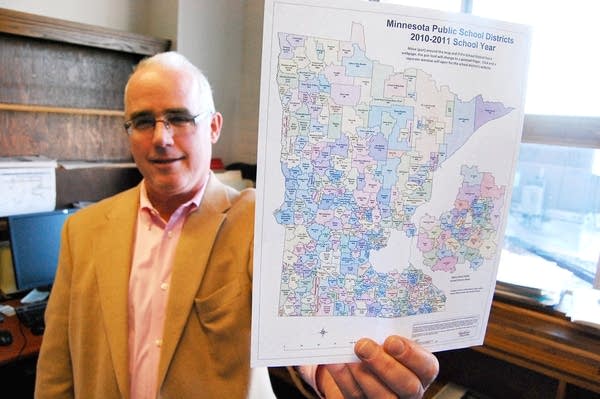Should Minnesota redraw school district boundaries?
Go Deeper.
Create an account or log in to save stories.
Like this?
Thanks for liking this story! We have added it to a list of your favorite stories.

Jim Tadlock has been living in the People Serving People homeless shelter for the last month.
Tadlock, who had to move when the home he was living in was lost to foreclosure, has never been homeless before. He's trying to hold things together, especially for his two sons, and has arranged for them to ride a bus to their schools in suburban Robbinsdale. He's worried they might be kicked out.
But if Tadlock's sons were to attend a closer school in Minneapolis, some of the extra money the state gives schools for each student affected by poverty wouldn't follow. Minneapolis officials say thousands of children switch districts every year and the state allocation never follows quickly enough.
The state could better serve children, like Tadlock's by redrawing school boundaries in a way that does not concentrate poverty, according to Jim Grathwol, the lobbyist for the Minneapolis School District.
Turn Up Your Support
MPR News helps you turn down the noise and build shared understanding. Turn up your support for this public resource and keep trusted journalism accessible to all.
Grathwol said the state could redistrict school districts the way it does legislative ones, so no single district becomes too concentrated with poverty over time.
In the Twin Cities, each metro district could be designed to be part-urban core, part-suburb and exurb. Instead of 30 metro districts with widely-varying rates of poverty, Grathwol envisions four or five metro districts.
One district could extend, for example, from downtown Minneapolis to Wayzata. Children there wouldn't necessarily have to go to school downtown, but Grathwol said the larger district would be a more efficient government entity.

"The question," he said, "is what's more important -- adult needs to have districts the way we've always had them? Or do find a way to more effectively deliver education to our students?"
Grathwol's point is highlighted by the fact that about 1,000 children live in downtown Minneapolis's three largest homeless shelters, where Tadlock lives.
"I've never been through this kind of thing, so I'm a rookie," said Tadlock, 49. "Some of these people have been through this before and it's a little easier for them. I don't know what the hell I'm doing."
He said being homeless has been hard on his sons, 16 and 13.
The oldest is "failing miserably right now -- and he's a smart kid," Tadlock said. "And my younger one -- he always gets straight A's and now he's getting suspended for fighting. So obviously he has anger issues."
Moving to a closer school in Minneapolis might help, but school district officials are concerned about how they could handle extra students without the state's poverty allocation.
Rethinking the way the state draws school boundaries might help, Minneapolis School Board member T. Williams said.
"The legislature and governor are going to have to set some limits and terms and say 'we are going to drag you into the 21st century screaming and yelling,'" said Williams, who is leaving the board in January.

Williams said population trends don't justify eight high schools within 10 miles of Southwest High, but there they are: Washburn and South in Minneapolis, Richfield, Edina, Bloomington's Kennedy, St. Louis Park, Hopkins and Robbinsdale.
He thinks leaders should come together to design a mega campus, designed for today's tech-heavy students, that draws from the entire area.
"We can't stay where we are - our schools will die on us," Williams said.
Scott Croonquist, a lobbyist for the 30 Twin Cities area districts, thinks the idea has merit.
"I think we have to look at a total redesign of public education," Croonquist said. "I don't know that this is the answer - it's a provocative idea, certainly, and one that should be talked about. But there might be other ideas, as well."
Even though Minneapolis officials don't expect the redrawing idea to pass next year, at least one legislative leader is also willing to listen.
State Rep. Pat Garofalo of Farmington, who will become chair of a key education committee when Republicans assume control of the House, wants to enact education reforms next year. He said he won't dismiss any idea, as long as it is based on data.
The Minneapolis School Board will decide Tuesday night whether to include the boundary idea in its legislative agenda.




